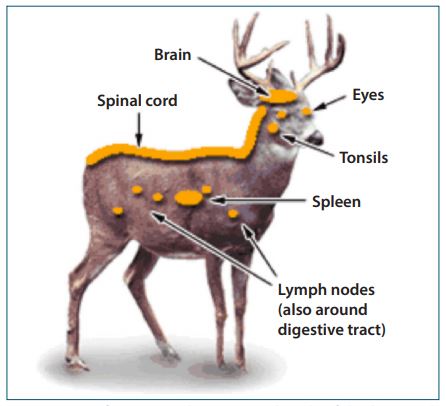There is no doubt that Chronic Wasting Disease (CWD) threatens deer hunting in Texas. The best way to avoid the impacts of the disease is to avoid spreading CWD from one place to another. In Texas, much of the white-tailed deer population is currently insulated from CWD, but we all have to do our part to keep it that way.
“Because many hunters process their own deer, they are key players in preventing environmental contamination or minimizing the spread of diseases such as CWD,” said Alan Cain, Texas Parks and Wildlife Department (TPWD) White-tailed Deer Program Leader. “One possible way that disease can spread is by the transportation and improper disposal of infected carcass parts.”
Transfer of CWD
Many deer species can become infected with CWD if they come into contact with other infected deer or an environment contaminated with CWD prions. While CWD prions are found ubiquitously throughout the body of an infected deer, they are known to accumulate in the brain, spinal cord, eyes, spleen, and lymph nodes. As such, it makes sense not to move these parts around and throw them in your back yard or the back 40.

This is a good idea for all deer hunters but is especially important and mandatory for hunters with CWD Containment and Surveillance Zones in Texas. Texas currently has three zones: Trans-Pecos, South Central and Panhandle CWD Containment and Surveillance Zones.
Hunters cannot take whole deer carcasses, or carcass parts that contain brain, spinal cord, eyes, spleen, or lymph nodes, out of the CWD zones or from another state or country known to have CWD.
Stop CWD: Stop Carcass Movement
“We recommend hunters in the CWD Containment and Surveillance Zones quarter deer in the field and leave all inedible parts at the site of harvest, or preferably dispose of in a landfill, or bury at site of harvest if possible,” Cain said. “Proper carcass disposal is good practice anywhere in the state, but especially critical in CWD zones.”
Cain also noted that hunters wishing to take an intact skinned or unskinned deer head to a taxidermist outside a CWD zone or from another CWD positive state or country may do so, but must obtain the Deer Head Waiver at any TPWD CWD check station or at the TPWD CWD website. The waiver should be completed and kept with the hunter or with the deer head until it reaches the taxidermist.
6 Tips for Proper Carcass Disposal
- Avoid cutting through bones, spine, or brain when processing deer carcasses.
- Place carcass parts in trash bags and properly dispose of them through a trash service or landfill.
- Remove all muscle and brain tissue from antlers attached to skull plates
- Remove all excess tissue from hides or capes
- Quarters or other portions of meat with no part of the spine or head attached
- Ideally, keep the carcass within the CWD zone for processing and taxidermy
Hunters in CWD Zones
Hunters who harvest deer and other CWD-susceptible species in the South Central zone during archery season beginning Sept. 28 are required to bring their animals to a TPWD check station within 48 hours of harvest in order to have tissue samples removed for CWD testing. Hunters will receive a proof-of-sex document at the check station, allowing them to lawfully dispose of the head as recommended.
Those hunting in the Trans-Pecos zone during archery season should call (512) 221-8491 and those hunting in the Panhandle zone during archery season should call (806) 420-0439, as check stations in these areas do not open until November.
“Texas Game Wardens will be doing compliance checks to make sure hunters are meeting the requirements in the CWD restricted zones and when bringing big game from CWD positive states, which includes Colorado, New Mexico and Wyoming,” said Region I Texas Game Warden Major Jason Huebner.
Proper deer carcass disposal is important for hunters within CWD zones to avoid the fines associated with state regulations to reduce the spread of CWD, but all hunters should be concerned with not fast-tracking the disease somewhere else in Texas.